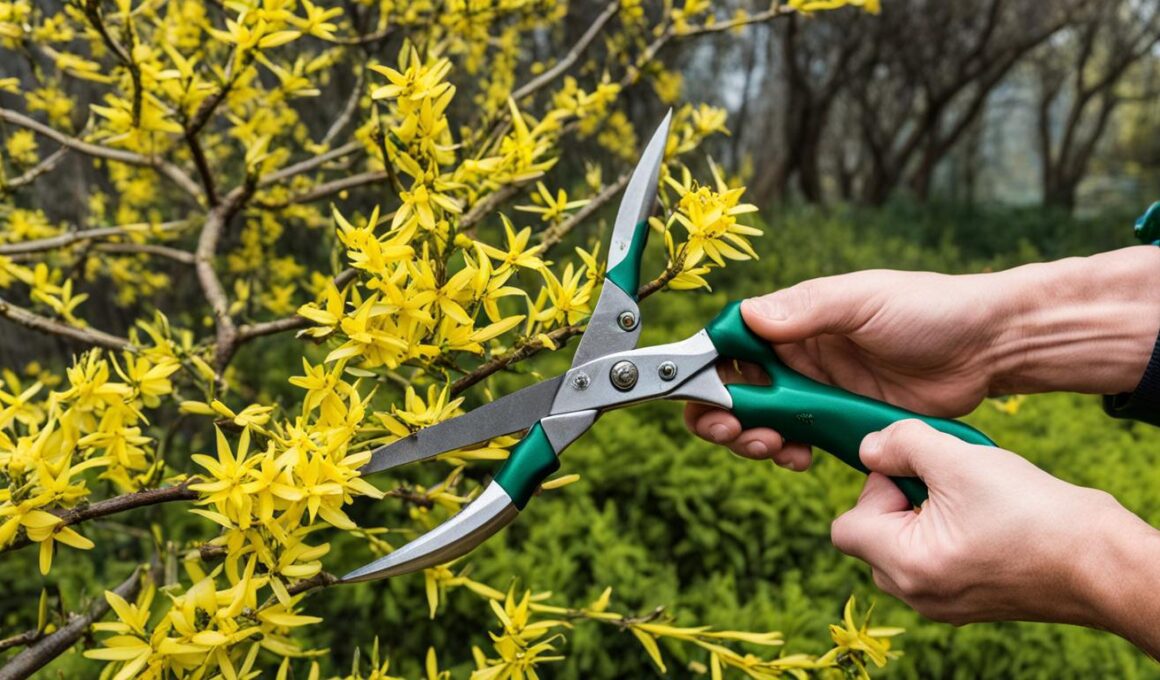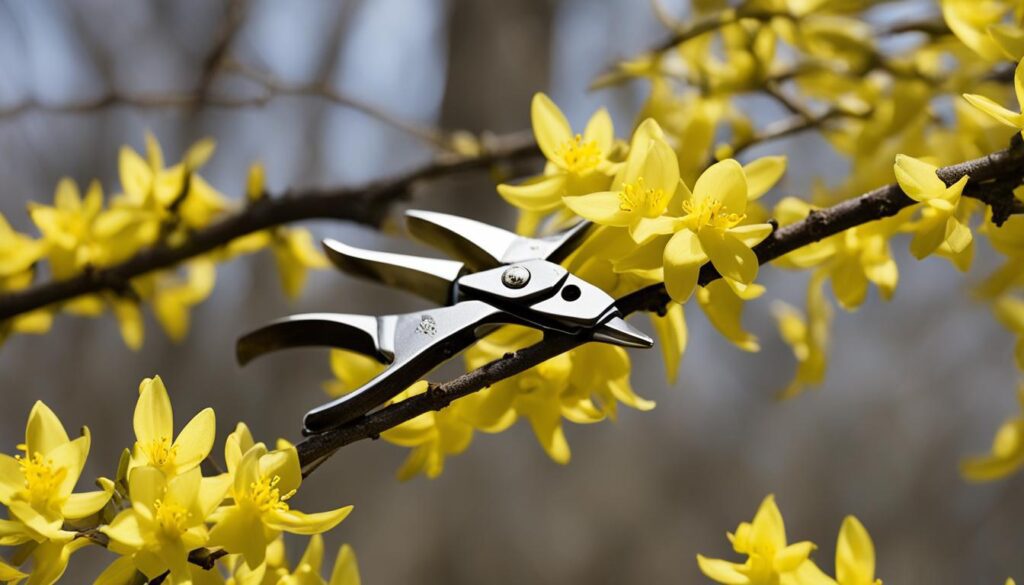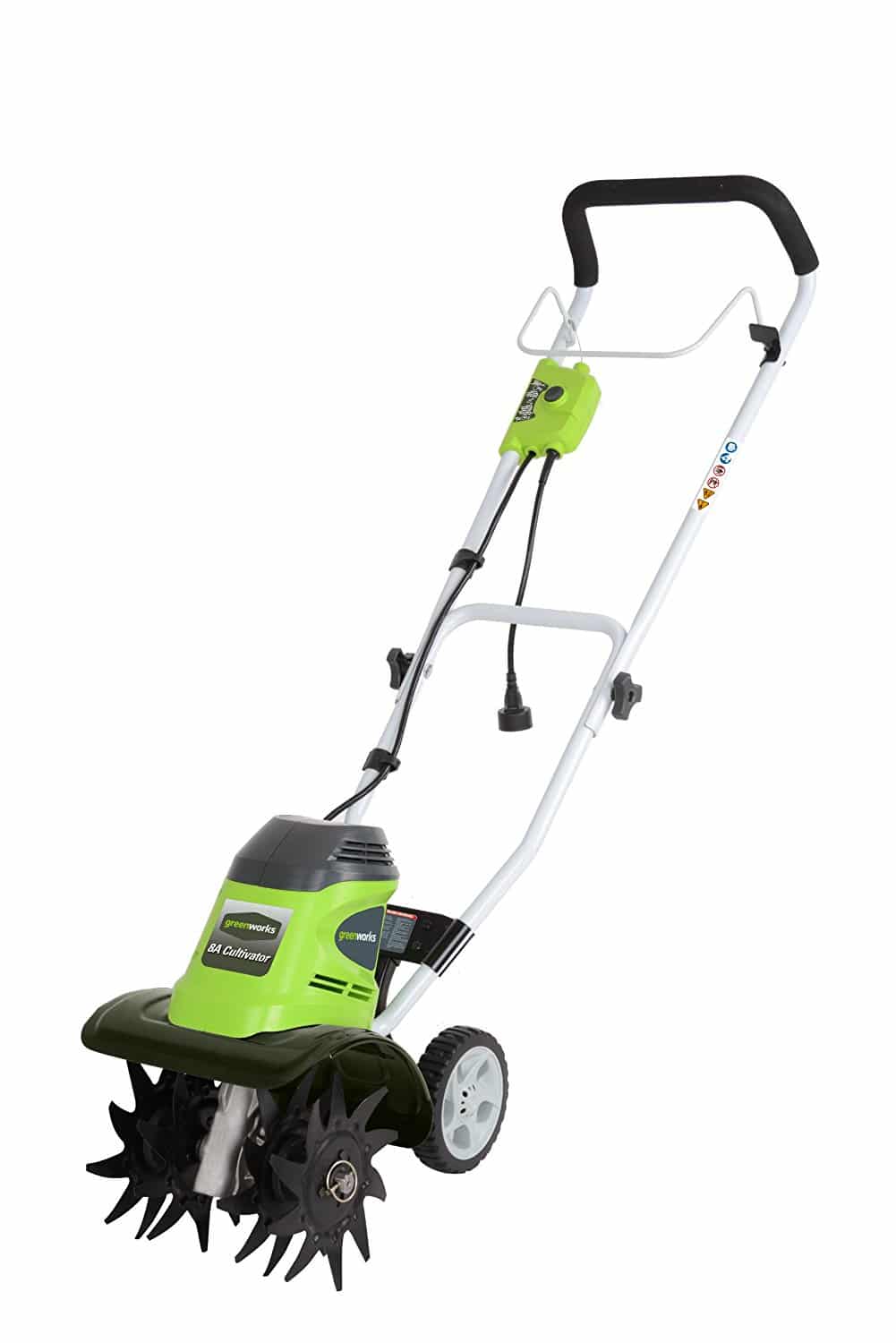Forsythia is a popular spring-flowering shrub known for its vibrant yellow flowers. To maintain its health and promote abundant blooms, it’s important to prune forsythia at the right time of year.
Pruning forsythia, also known as trimming forsythia, is essential for maintaining the shape and health of the shrub. By pruning, you can ensure the shrub remains vigorous and encourages new growth, resulting in a more stunning display of flowers.
So, when is the best time to prune forsythia? The ideal time to trim forsythia is shortly after it has finished flowering. Forsythia blooms on the current season’s growth, so by pruning it after the flowering period, you allow the plant enough time to put on new growth and develop flower buds for the following year.
It is crucial to complete all pruning before mid-July. Pruning after this timeframe may result in cutting off the flower buds for the next season, leading to a reduced flower show.
Using the right tools and techniques is also essential when pruning forsythia. Pruning shears and loppers are ideal tools for cutting smaller and thicker branches, respectively. Clean cuts should be made near the ground or where the branch meets another branch to encourage new growth.
Whether you are shaping the shrub, rejuvenating an overgrown forsythia, or maintaining a formal hedge, pruning forsythia at the proper time and using the right techniques will ensure a healthy and visually appealing shrub.
Tools and Techniques for Pruning Forsythia
When it comes to pruning forsythia, having the right tools and using the proper techniques is essential for maintaining the health and appearance of your shrub. Whether you’re trimming to maintain shape or rejuvenate an overgrown plant, here are some key tools and techniques to consider.
Pruning Tools
Pruning Shears: Pruning shears, also known as hand pruners, are the go-to tool for cutting small branches up to half an inch in diameter. These handheld tools provide precision and control, making clean cuts a breeze.
Loppers: For thicker stems and branches up to an inch in diameter, loppers are your best bet. With their long handles and robust cutting blades, they offer the leverage and power needed to tackle more substantial pruning tasks.
Pruning Saw: When dealing with larger branches, a small pruning saw can come in handy. Its sharp teeth and sturdy construction make cutting through slightly thicker branches a manageable feat.
Pruning Techniques
To ensure the best results when pruning forsythia, follow these techniques:
- Clean Cuts: When pruning, make clean cuts near the ground or where the branch meets another branch. This encourages new growth and prevents the development of stubs that can lead to diseases or pest infestations.
- Rejuvenation Pruning: If you have an overgrown forsythia with limited blooms, consider rejuvenation pruning. This technique involves cutting all branches to the ground, essentially starting fresh. However, be aware that this approach may result in a lack of flowers in the following spring.
- Progressive Pruning: To maintain the shape of your forsythia, consider progressive pruning. This technique involves removing one-third of the oldest branches each year. By staggering the pruning over time, you can keep the shrub looking neat and prevent overwhelming growth.
With the right tools and techniques in your gardening arsenal, pruning forsythia can be a rewarding and effective way to keep your shrub healthy and thriving.
Tips for Pruning Forsythia for Different Purposes
When it comes to pruning forsythia, there are various techniques you can employ depending on your desired outcome. If you’re looking to shape the shrub, you can focus on pruning individual branches to create a more natural and wild appearance. Consider allowing branches to reach different lengths to achieve the desired effect. This approach can give your forsythia a unique and charming look.
On the other hand, if you’re aiming for a formal hedge, regular pruning is essential to maintain a specific shape. Trimming the tips of branches can help keep the hedge looking neat and tidy. However, it’s important to note that this method may lead to fewer flowers and less foliage in the center of the hedge. Regular maintenance is crucial to strike the right balance.
In cases where you’re dealing with an overgrown forsythia, rejuvenation is possible through the coppicing method. This technique involves cutting the entire shrub back to the ground. While it may seem drastic, coppicing promotes new growth and can help rejuvenate the plant. Aim to perform this rejuvenation process every three to four years. Keep in mind, though, that cutting the entire shrub back to the ground may result in a lack of flowers in the following spring.
Is the Timing for Trimming Forsythia Similar to Pruning Monstera Plants?
Yes, the timing for trimming forsythia is similar to pruning Monstera plants. Both are best done in the spring after the plants have finished flowering. When using pruning monstera plant techniques, it’s important to trim forsythia to maintain its shape and encourage new growth.










